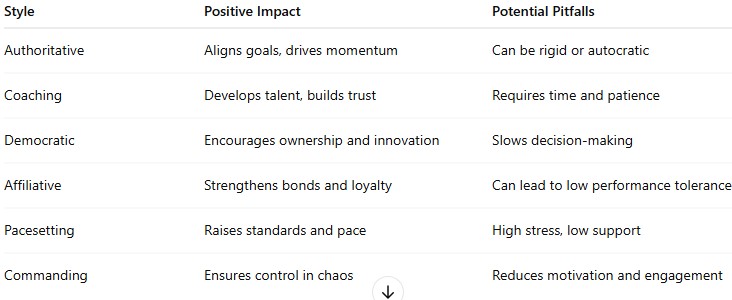1. Authoritative – “Follow me”
Traits: Vision-driven, clear direction, strong sense of mission
Best for: Teams lacking direction or undergoing major change
Strengths: Provides clarity and quick alignment
Weaknesses: May suppress team input or creative thinking
2. Coaching – “What do you want to become?”
Traits: Development-focused, empowering, supportive
Best for: Teams with potential and willingness to grow
Strengths: Builds long-term talent and loyalty
Weaknesses: Time-consuming, slower short-term results
3. Democratic – “What’s your opinion?”
Traits: Participatory, consensus-seeking, inclusive decision-making
Best for: Skilled, experienced teams with strong collaboration
Strengths: Promotes innovation and shared responsibility
Weaknesses: Can slow decision-making and delay action
4. Affiliative – “We’re in this together”
Traits: Relationship-oriented, emotionally supportive
Best for: Rebuilding trust, easing tension, or post-conflict periods
Strengths: Improves morale, reduces turnover
Weaknesses: May overlook performance issues or accountability gaps
5. Pacesetting – “Watch how I do it”
Traits: High standards, leads by example, fast execution
Best for: High-performing teams under time pressure
Strengths: Drives efficiency and excellence
Weaknesses: Overwhelms average performers, lacks mentoring
6. Commanding – “Just do it”
Traits: Directive, discipline-oriented, top-down control
Best for: Crisis situations or poorly structured environments
Strengths: Fast implementation, tight control
Weaknesses: Demoralizing over time, stifles creativity





